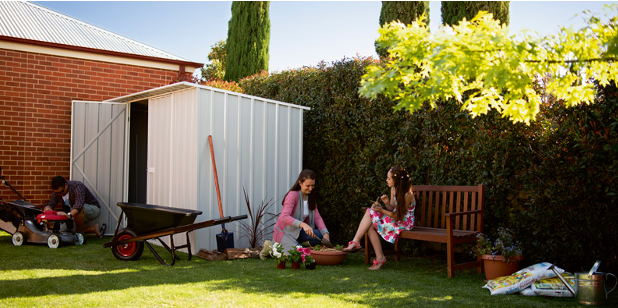Picking the Perfect Material for Garden Shed Construction
- Written by News Feature Team

At one time, outdoor sheds were just places to hold shovels, mowers, weed trimmers and other tools used to keep the outdoor spaces looking good. They have now graduated to all-purpose storage buildings that come in all sizes. Some garden sheds are used to store items that would otherwise clutter up the garage or basement. Others may even include electricity to provide light and climate control to make them useful as hobby workshops. Sheds are now available in everything from wood to plastic with each material having its own usefulness.
Plastic Garden Sheds
Sunlight degrades the look and strength of plastic sheds over time. Typically, plastic is even used in the door hinge construction of many sheds, and the locking hasp is often made of plastic. The lighter weight of plastic sheds give them less resistance to wind damage, and it does not require much effort to break into one, making them the least secure of all garden sheds.
Plastic is better suited for outdoor cabinets and boxes to store items often used around pool, patio and deck areas. Plastic is impervious to water damage and will not rot. Plastic is also not a food source for insects and is useful where wood-boring insects might be a problem. Plastic garden sheds are also easy to erect with a little help, and no carpentry skills are needed. Plastic sheds can also be placed on bare soil without worry of them rotting. However, an anchoring system should be used to help prevent them from moving in windy areas.
Wood Garden Sheds
Most outdoor buildings made of wood are a mix of treated and untreated lumber. Treated lumber holds up better to rot and damage from insects. A typical wooden garden shed is constructed of a floor frame made of treated lumber with the rest of the framing made from untreated lumber.
Flooring and roof sheathing is often OSB that is highly susceptible to moisture damage and rot. Higher grade plywood rated for exterior use greatly increases the price. Exterior wall surfaces can be made from numerous wood materials, but all of them require regular painting, staining or sealing. Wood sheds should be elevated above soil contact on a bed of gravel to delay damage caused by moisture. Moderate carpentry skills are also required to build wooden sheds.
Metal Garden Sheds
Steel is the most common metal used in exterior shed construction. Steel buildings can be constructed as small as an exterior shelter for tools and objects for use around pools or patios to large commercial buildings and even Class 1a liveable dwellings. Steel sheds are durable and can be highly customised depending on consumer needs. Steel can be placed over a gravel base, or it can be anchored to wood or concrete floor structures. Steel can also support swinging or overhead doors (garage doors), and garden shed designs are crafted to make assembly easy with some assistance. This Geelong garden sheds page on Sheds n Homes website shows just how simple it is to erect these DIY sheds. Steel sheds with intact surface coatings can outlast other materials, visit The Shed Man.
Coloured steel does not require painting, and there is a wide range of colours that steel garden sheds are available in. Coatings used in steel garden shed construction today offer a greater degree of rust protection than those kit sheds that were popular years ago. Deep scratches in steel coatings that go down to the bare steel should be sealed to prevent rust from forming where the protective coatings is compromised.
Steel surfaces may get hotter than wood, but the interior temperature of the shed should not vary greatly from one construction material to the next. Placement and ventilation help in controlling temperature. All sheds should have ventilation panels installed, including plastic sheds. Locating sheds under a shady tree can greatly decrease internal temperatures on a hot day.
Plastic, wood and steel garden sheds can all be recycled at the end of their service life, but steel retains a resale scrap value that plastic and wood do not. Though plastic is projected to persist in landfills for hundreds of years, it does not last forever as a shed-building material. Sunlight can degrade some plastic sheds to the point of becoming brittle in just a few years. Wood needs regular maintenance, or it will eventually succumb to rot or moisture damage. Steel sheds with intact surface coatings can outlast other materials.





